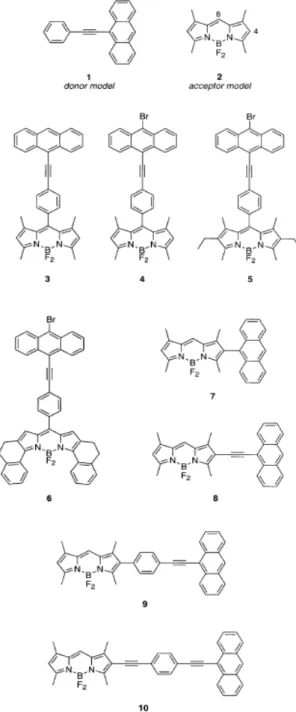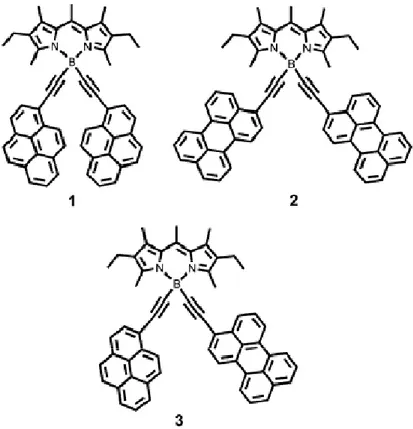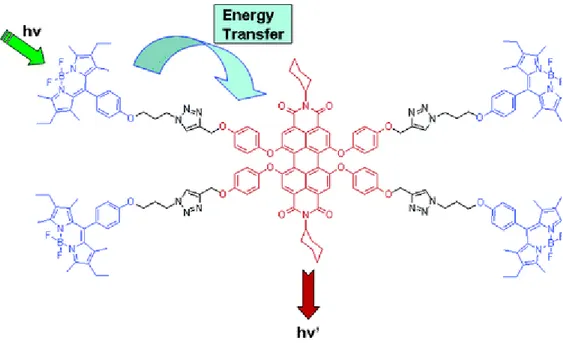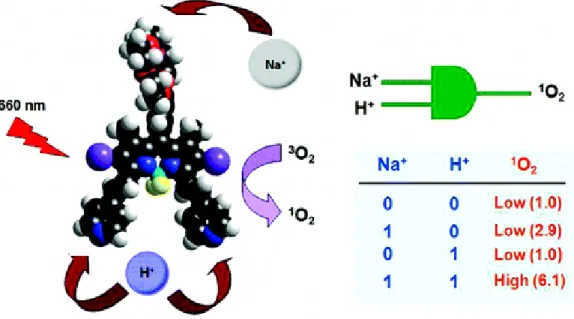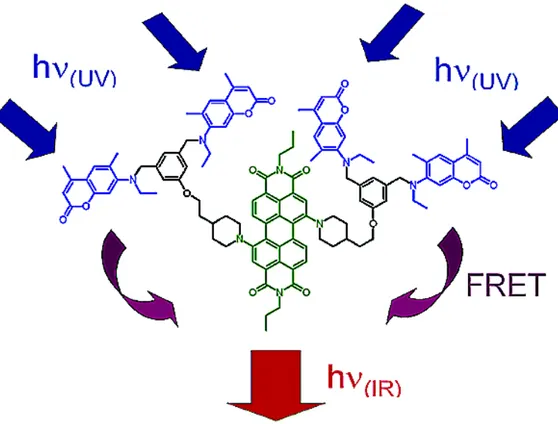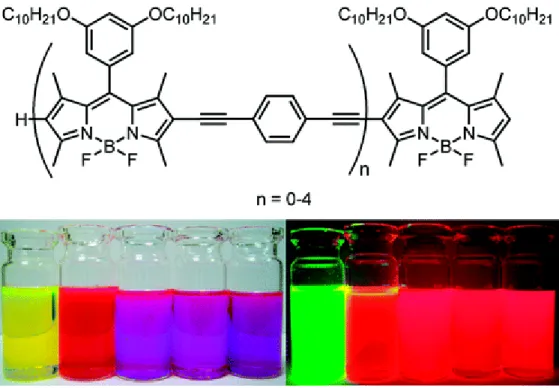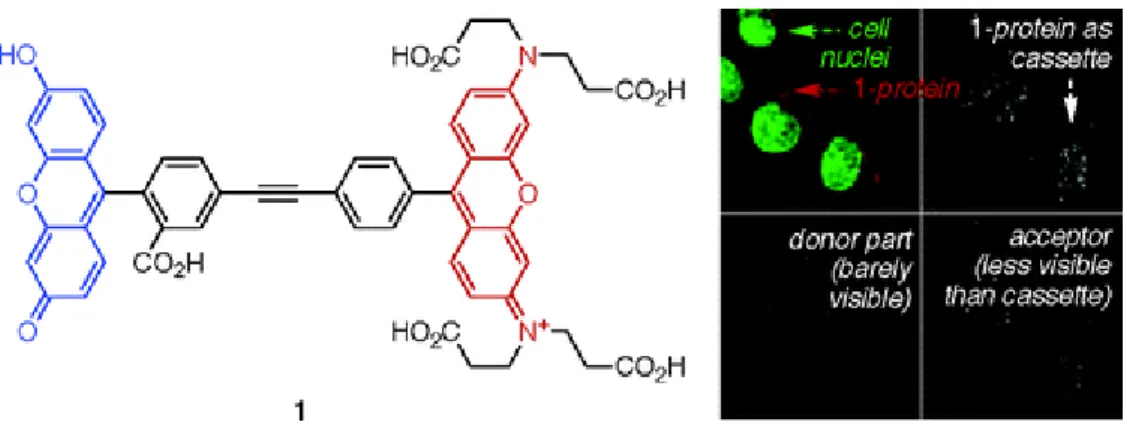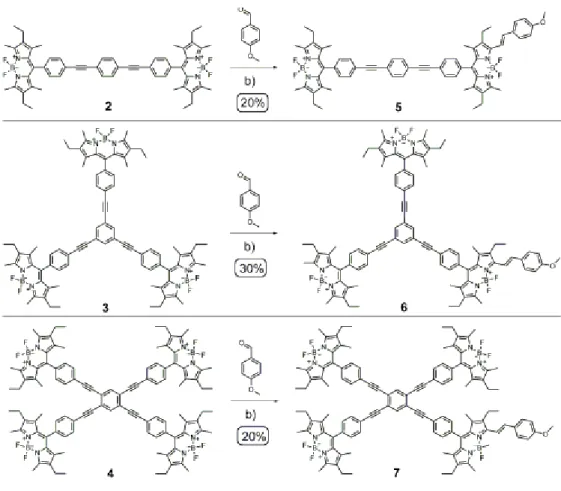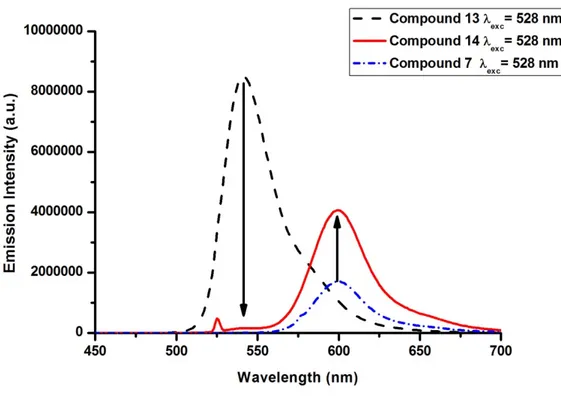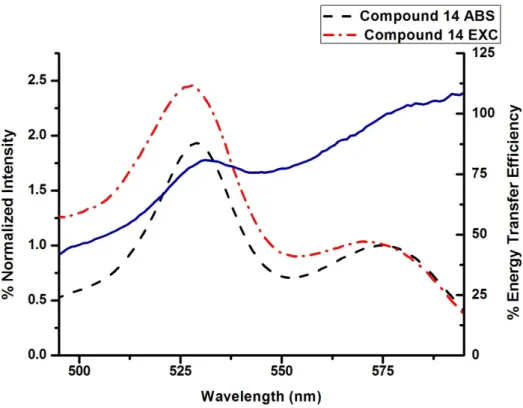NOVEL MULTICHROMOPHORIC ENERGY TRANSFER
CASSETTES BASED ON FUNCTIONALIZED BODIPY
DYES
A THESIS
SUBMITTED TO THE MATERIALS SCIENCE AND
NANOTECHNOLOGY PROGRAM OF THE GRADUATE SCHOOL OF ENGINEERING AND SCIENCE OF BİLKENT UNIVERSITY
IN PARTIAL FULFILLMENT OF THE REQUIREMENTS FOR THE DEGREE OF
MASTER OF SCIENCE
By
GİZEM ÇELTEK September 2012
I certify that I have read this thesis and that in my opinion it is fully adequate, in scope and in quality, as a thesis of the degree of Master of Science.
Prof. Dr. Engin U. Akkaya (Principal Advisor)
I certify that I have read this thes
in scope and in quality, as a thesis of the degree of Master of Science.
I certify that I have read this thesis and that in my opinion it is fully adequate, in scope and in quality, as a thesis of the degree of Master of Science.
Approved for the Graduate School of Engineering and Science:
Director of the Graduate School
certify that I have read this thesis and that in my opinion it is fully adequate, in scope and in quality, as a thesis of the degree of Master of Science.
………. Prof. Dr. Engin U. Akkaya (Principal Advisor)
I certify that I have read this thesis and that in my opinion it is fully adequate, in scope and in quality, as a thesis of the degree of Master of Science.
………. Asst. Prof. Dr. Turgay Tekinay
I certify that I have read this thesis and that in my opinion it is fully adequate, n scope and in quality, as a thesis of the degree of Master of Science.
………. Asst. Prof. Dr. Serdar Atılgan
Approved for the Graduate School of Engineering and Science:
………. Prof. Dr. Levent Onural
Director of the Graduate School of Engineering and Science
certify that I have read this thesis and that in my opinion it is fully adequate, in scope and in quality, as a thesis of the degree of Master of Science.
Prof. Dr. Engin U. Akkaya (Principal Advisor)
is and that in my opinion it is fully adequate, in scope and in quality, as a thesis of the degree of Master of Science.
I certify that I have read this thesis and that in my opinion it is fully adequate, n scope and in quality, as a thesis of the degree of Master of Science.
Approved for the Graduate School of Engineering and Science:
ABSTRACT
NOVEL MULTICHROMOPHORIC ENERGY TRANSFER
CASSETTES BASED ON FUNCTIONALIZED BODIPY DYES
Gizem ÇELTEK
M.S. in Material Science and Nanotechnology Supervisor: Prof. Dr. Engin U. Akkaya
September, 2012
Energy necessity is one of the leading problems in the world due to the developing technologies and strategies. There are many energy sources, which are being used for years, however; conversion and transfer of the energy is a problem in many fields due to energy loss. In this manner, the efficiency of energy transfer is very crucial. For this purpose, we have designed multichromophoric molecules, which can absorb the light with donor parts, then transfer the energy to the acceptor site. During this process, energy loss is tried to be prevented by lowering the distance between the donor and acceptor Boradiazaindacene (BODIPY) molecules. Three different energy transfer cassettes are synthesized and characterized. The design of the supramolecule, in means of spectral overlap and distance between the donor and the acceptor site are observed to affect the energy transfer efficiency. Through functional design, these molecules absorb and emit light in different wavelengths. Substation of distyryl and tetrastyryl groups to the acceptor BODIPY core changes the emission and absorption maxima. Increasing number of styryl groups attached to the molecule shifts the spectrum to the red part of the visible region. Through rational design, these molecules can be used in applications of energy transfer and broad spectrum absorber purposes.
Keywords: Boradiazaindacene (BODIPY), dye, supramoleculer chemistry, multichromophore, energy transfer, Sonogashira coupling.
ÖZET
FONKSİYONLANDIRILMIŞ BODİPY BOYALARINA
DAYANAN YENİ MULTİKROMOFORLU ENERJİ AKTARIM
KASETLERİ
Gizem ÇELTEK
Yüksek Lisans, Malzeme Bilimi ve Nanoteknoloji Programı Tez Yöneticisi: Prof. Dr. Engin U. Akkaya
Eylül, 2012
Gelişen teknoloji ve strateji yüzünden, enerji gereksinimi dünyada belli başlı sorunlardan biri haline gelmiştir. Yıllardır kullanılan birçok enerji kaynağı olmasına rağmen, enerji dönüşümü ve transferi, oluşan enerji kaybı nedeniyle bir çok alanda problem olmuştur. Bu bağlamda, enerji transferinin verimi önemli bir rol oynamaktadır. Bu nedenle, ışığı donör kısımları ile absorblayıp, bu enerjiyi akseptör kısma transfer edebilen multikromoforlu moleküller dizayn edilmiştir. Transfer sırasındaki enerji kaybını önlemek için, donör ve akseptör Boradiazaindasen (BODIPY) molekülleri arasındaki uzaklık mümkün olduğunca kısaltılmıştır. Üç farklı yapıda enerji transfer kaseti sentezlenmiş ve analizleri başarıyla gerçekleştirilmiştir. Süpramolekülün dizaynının, donör ve akseptör molekülün arasındaki spektral çakışma ve uzaklık bakımından, enerji transferinin verimini etkilediği gözlemlenmiştir. Fonksiyonel dizaynı sayesinde bu moleküller ışığı farklı dalga boylarında absorblamakta ve yaymaktadırlar. Akseptör BODİPY çekirdeğine substite edilen di-stiril ve tetra-stiril grupları, absorbsiyon ve ışıma en üst değerlerini değiştirmektedir. Moleküle substite edilen stiril gruplarının artması, spektrumu görünür bölgenin kırmızı kısmına kaydırmaktadır. Bu moleküller rasyonel dizayn yapılması durumunda, enerji transferi uygulamalarında ve geniş spektrumda absorbansı olan boya gereksinimi olan amaçlarda kullanılabilirler.
Anahtar Kelimeler: Boradiazaindasen (BODIPY), boya, süpramoleküer kimya, multikromofor, enerji aktarımı, Sonogashira bağlaması.
Wxw|vtàxw àÉ Åç ctÜxÇàá
Wxw|vtàxw àÉ Åç ctÜxÇàá
Wxw|vtàxw àÉ Åç ctÜxÇàá
Wxw|vtàxw àÉ Åç ctÜxÇàá
ACKNOWLEDGEMENT
I would like to express my gratitude to my supervisor Prof. Dr. Engin U. Akkaya for his guidance, support and patience during the course of this research. I am also grateful to him for being lead and teaching how to become a good scientist I will never forget his support throughout my life.
I owe a special thank to Yusuf Çakmak for his generous help in Time-resolved Fluorescence analysis. I would like to thank Fazlı Sözmen, for his partnership in this research.
I want to thank our group members Sündüs Erbaş Çakmak, Murat Işık, Esra Eçik Tanrıverdi, Ayşegül Gümüş, Ruslan Guliyev, Bilal Kılıç, Safacan Kölemen, Seda Demirel, Onur Büyükçakır, İlke Şimşek Turan, Nisa Yeşilgül, Ziya Köstereli, Tuğba Özdemir Kütük, Şeyma Öztürk, Fatma Pir Çakmak, Tuğçe Durgut, Fatma Tuba Yaşar, Muhammed Büyüktemiz, Taha Bilal Uyar, Ahmet Atılgan, Yiğit Altay and rest of the SCL (Supramolecular Chemistry Laboratory) members for valuable friendships, wonderful collaborations, and great ambiance in the laboratory. It was wonderful to work with them.
I would like to thank to TÜBİTAK (The Scientific and Technological Research Council of Turkey) for financial support.
I would like to express my special thanks to my valuable friends Ateş Derviş, İrem Sak, Elif Ertem, Kutay Yıldız, Damla Şenol, Hatice Turgut, Hami Tural and Mehmet Uğur Öney for adding joy to my time during the course of this research.
Finally, I want to express my gratitude to my family for their encouragement, love, support, and understanding. I owe them a lot.
LIST OF ABBREVIATIONS
BODIPY: Boradiazaindacene
DNP: Dinitrophenyl hydrazine TFA: Trifluoroacetic acid
DCM: Dichloromethane
THF: Tetrahydrofuran
DIPA: Diisopropyl amine
DMF: Dimethylformamide
NBS: N-Bromosuccinimide
FRET: Förster Resonance Energy Transfer
TLC: Thin layer chromatography
NMR: Nuclear magnetic resonance
CHCl3: Chloroform
RT: Room Temperature
MeOH: Methanol
EtOH: Ethanol
AcOH: Acetic Acid
HOMO: Highest occupied molecular orbital
TABLE OF CONTENTS
INTRODUCTION ... 1
1.1. BODIPY Dyes ... 1
1.1.2. Applications of BODIPY dyes in Literature ... 3
1.2. Cross Coupling Reactions ... 9
1.2.1. Sonogashira Coupling ... 10
1.2.2. Sonogashira Coupling Mechanism ... 11
1.2.3. Applications of Sonogashira coupling in literature ... 13
1.3. Transfer mechanisms of electronic excitation ... 15
1.3.1. Through-space Energy Transfer ... 16
1.3.2. Through-bond Energy Transfer ... 18
EXPERIMENTAL ... 22 2.1. General ... 22 2.2. Syntheses ... 23 2.2.1. Synthesis of Compound 3... 23 2.2.2. Synthesis of Compound 4... 24 2.2.3. Synthesis of Compound 5... 25 2.2.4. Synthesis of Compound 6... 27 2.2.5. Synthesis of Compound 7... 28 2.2.6. Synthesis of Compound 10... 29 2.2.7. Synthesis of Compound 12... 31 2.2.8. Synthesis of Compound 13... 32 2.2.9. Synthesis of Compound 14... 33 2.2.10. Synthesis of Compound 16 ... 34 2.2.11. Synthesis of Compound 17 ... 35 2.2.12. Synthesis of Compound 18 ... 37
2.2.13. Synthesis of Compound 19 ... 38
2.2.14. Synthesis of Compound 20 ... 39
RESULTS and DISCUSSION ... 41
3.1. General Perspective ... 41
3.2. Design and Working Principle of Target Compounds ... 43
3.3. Spectroscopic Properties ... 44
3.4. Photophysical Data ... 52
CONCLUSION ... 55
REFERENCES ... 56
APPENDIX A - NMR SPECTRA ... 61
LIST OF FIGURES
Figure 1: Position Numbering of BODIPY core. ... 2
Figure 2: Knoevenagel Condensation From 3rd and 5th position ... 3
Figure 3: Energy transfer cassettes based on BODIPY dyes prepared by Sonogashira coupling10a. Copyright © 2003 Wiley-VCH Verlag GmbH&Co. KGaA, Weinheim. Adapted with permission. ... 4
Figure 4: BODIPY-based cascade type dyes studied by R. Ziessel and his team12. ... 5
Figure 5: Light harvesting molecule with perylenediimide groups by E. U. Akkaya and his team13. Copyright © 2006 American Chemical Society. Adapted with permission. ... 6
Figure 6: Schematic Representation of solar Energy transfer. Copyright © 2011 Wiley-VCH Verlag GmbH&Co. KGaA, Weinheim. Adapted with permission.7 Figure 7: Photodynamic therapy reagent for cancer treatment. Copyright © 2008 American Chemical Society. Adapted with permission. ... 8
Figure 8: Aqueous Suzuki−Miyaura cross coupling for proteins. Copyright © 2009 American Chemical Society. Adapted with permission. ... 9
Figure 9: Sonogashira Coupling reaction conditions ... 10
Figure 10: Cu-cocatalyzed Sonogashira Coupling Mechanism14 ... 11
Figure 11: Synthesis of a Biotin-Derived Alkyne29 ... 13
Figure 12: Synthesis of natural products (+)-(S)-laudanosine and (–)-(S)-xylopinine31. ... 14
Figure 13: Light harvesting assembly with four porphyrin units33. ... 14
Figure 14: Through-bond (Dexter) and Through-space (FRET) energy transfer ... 15
Figure 15: FRET mechanism used for biological chemosensors37. Copyright © 2010 American Chemical Society. Adapted with permission. ... 17
Figure 16: FRET mechanism in dendrimeric structure38. Copyright © 2002 American Chemical Society. Adapted with permission. ... 17
Figure 17: pH-dependent FRET39. ... 18
Figure 18: Through-bond energy transfer oligomers. Copyright © 2008 American Chemical Society. Adapted with permission. ... 19
Figure 19: Water-soluble through bond energy transfer cassettes. Copyright ©
2006 American Chemical Society. Adapted with permission. ... 20
Figure 20: Symmetrical Through-bond energy transfer cassettes43. ... 21
Figure 21. Synthesis of Compound 3 ... 24
Figure 22. Synthesis of Compound 4 ... 25
Figure 23. Synthesis of Compound 5-1 ... 26
Figure 24. Synthesis of Compound 5 ... 27
Figure 25. Synthesis of Compound 6 ... 28
Figure 26. Synthesis of Compound 7 ... 29
Figure 27. Synthesis of Compound 10 ... 30
Figure 28. Synthesis of Compound 12 ... 31
Figure 29. Synthesis of Compound 13 ... 32
Figure 30. Synthesis of Compound 14 ... 34
Figure 31. Synthesis of Compound 16 ... 35
Figure 32. Synthesis of Compound 17 ... 36
Figure 33. Synthesis of Compound 18 ... 37
Figure 34. Synthesis of Compound 19 ... 39
Figure 35. Synthesis of Compound 20 ... 40
Figure 36. Possible modification positions of BODIPY core ... 41
Figure 37. Possible modification positions of BODIPY core ... 42
Figure 38. Donor (13) and Acceptor (7) components of Compound 14 ... 43
Figure 39. Normalized Absorbance Spectrum of Donor (13), Acceptor (7) and Target (14) ... 45
Figure 40. Normalized Emission Spectrum of Donor (13), Acceptor (7) and Target (14) ... 46
Figure 41. % Energy Transfer Efficiency of Compound 14 ... 47
Figure 42. Normalized Absorbance Spectrum of Donor (13), Acceptor (16) and Target (17) ... 48
Figure 43. Normalized Emission Spectrum of Donor (13), Acceptor (16) and Target (17) ... 49
Figure 44. % Energy Transfer Efficiency of Compound 17 ... 49
Figure 45. Normalized Absorbance Spectrum of Donor (13), Acceptor (19) and Target (20) ... 50
Figure 46. Normalized Emission Spectrum of Donor (13), Acceptor (19) and
Target (20) ... 51
Figure 47. Normalized Emission Spectrum of Target 14, 17 and 20 ... 51
Figure 48. Normalized Excitation Spectrum of Target 14, 17 and 20 ... 52
Figure 49: Target molecules (left) under UV light (right). ... 54
Figure 50. 1H NMR spectrum of Compound 3 ... 61
Figure 51. 13C NMR spectrum of Compound 3 ... 62
Figure 52. 1H NMR spectrum of Compound 4 ... 63
Figure 53. 13C NMR spectrum of Compound 4 ... 64
Figure 54. 1H NMR spectrum of Compound 5 ... 65
Figure 55. 1H NMR spectrum of Compound 6 ... 66
Figure 56. 13C NMR spectrum of Compound 6 ... 67
Figure 57. 1H NMR spectrum of Compound 7 ... 68
Figure 58. 13C NMR spectrum of Compound 7 ... 69
Figure 59. 1H NMR spectrum of Compound 10 ... 70
Figure 60. 13C NMR spectrum of Compound 10 ... 71
Figure 61. 1H NMR spectrum of Compound 12 ... 72
Figure 62. 13C NMR spectrum of Compound 12 ... 73
Figure 63. 1H NMR spectrum of Compound 13 ... 74
Figure 64. 13C NMR spectrum of Compound 13 ... 75
Figure 65. 1H NMR spectrum of Compound 14 ... 76
Figure 66. 13C NMR spectrum of Compound 14 ... 77
Figure 67. 1H NMR spectrum of Compound 16 ... 78
Figure 68. 13C NMR spectrum of Compound 16 ... 79
Figure 69. 1H NMR spectrum of Compound 17 ... 80
Figure 70. 13C NMR spectrum of Compound 17 ... 81
Figure 71. 1H NMR spectrum of Compound 18 ... 82
Figure 72. 13C NMR spectrum of Compound 18 ... 83
Figure 73. 1H NMR spectrum of Compound 19 ... 84
Figure 74. 13C NMR spectrum of Compound 19 ... 85
Figure 75. 1H NMR spectrum of Compound 20 ... 86
Figure 76. 13C NMR spectrum of Compound 20. ... 87
Figure 78. ESI-HRMS of Compound 4 ... 88
Figure 79. ESI-HRMS of Compound 5 ... 89
Figure 80. ESI-HRMS of Compound 6 ... 89
Figure 81. ESI-HRMS of Compound 7 ... 90
Figure 82. ESI-HRMS of Compound 10 ... 90
Figure 83. ESI-HRMS of Compound 12 ... 91
Figure 84. ESI-HRMS of Compound 13 ... 91
Figure 85. ESI-HRMS of Compound 14 ... 92
Figure 86. ESI-HRMS of Compound 16 ... 92
Figure 87. ESI-HRMS of Compound 17 ... 93
Figure 88. ESI-HRMS of Compound 18 ... 93
Figure 89. ESI-HRMS of Compound 19 ... 94
LIST OF TABLES
CHAPTER 1
INTRODUCTION
1.1.
BODIPY Dyes
Boradiazaindacene (BODIPY) dyes were first synthesized in 1968, about half century ago, by Kreuzer and Treibs1. Due to the ease of synthesis, high quantum yield and tunability of spectrum by functionalization, BODIPY dyes accomplished great interest among many research groups. In addition, these dyes are relatively stable and can dissolve in both organic and inorganic solvents through rational design. After the initial synthesis, these colorful molecules make use in biological imaging2, chemosensors3 and light harvesting systems4.
BODIPY molecule has many advantageous properties. For instance, these molecules can easily be functionalized by using coupling and condensation reactions. In recent years, BODIPY chemistry becomes a main interest of many research groups, demonstrating the rich chemistry5. Possible chemical modifications of different positions of the core, makes it easier to functionalize the molecule for structural and photophysical purposes. Substitution of 1st, 3rd, 5th and 7th position with suitable groups using condensation reactions generally yields with long wavelength absorbing and emitting dyes6. Naked BODIPY molecule has an absorption value around 500 nm. Incorporation of aromatic rings and groups from meso position does not cause a significant change in the photophysical properties of the molecule7.
Position numbering for BODIPY molecules can sometimes be confusing, however; α and β signatures make it easier to indicate the positions. In addition, 8th position of the core has a special name called meso position. (Figure 1)
Figure
Halogenation of 2
successful metal coupling reactions like Sonogashira and Suzuki coupling. Since these positions have the relatively least positive charge than other positions, electrophilic attacks are possible. Halogenations
implemented with excess use of halogen in organic solvents for both 2
positions. Mono-halogenation is also possible with suitable reaction conditions. However, halogenation generally has a disadvantage: it reduces the quantum yield by quenching the fluorescence, due to heavy atom effect. The spectrum generally shifts to red region and molecule gains deep pinkish color
When treated with clorosulphonic acid, 2 BODIPY molecule gives electrophilic substation react
BODIPY core becomes soluble in water, which can be used for biological purposes. This process also provides stability to the BODIPY core.
3rd and 5
Knoevenagel condensation r
acidic, condensation with an aldehyde is applied to the molecule. The reaction generally gives high yields with the naked BODIPY core and functionalized
Figure 1: Position Numbering of BODIPY core.
Halogenation of 2nd and 6th position of the core has an important role in successful metal coupling reactions like Sonogashira and Suzuki coupling. Since these positions have the relatively least positive charge than other positions, electrophilic attacks are possible. Halogenations
implemented with excess use of halogen in organic solvents for both 2
halogenation is also possible with suitable reaction conditions. However, halogenation generally has a disadvantage: it reduces the quantum quenching the fluorescence, due to heavy atom effect. The spectrum generally shifts to red region and molecule gains deep pinkish color
When treated with clorosulphonic acid, 2nd and 6
BODIPY molecule gives electrophilic substation reaction8. After the treatment, BODIPY core becomes soluble in water, which can be used for biological purposes. This process also provides stability to the BODIPY core.
and 5th positions of the core are also be functionalized by Knoevenagel condensation reaction. Since methyl groups on this position are acidic, condensation with an aldehyde is applied to the molecule. The reaction generally gives high yields with the naked BODIPY core and functionalized
Position Numbering of BODIPY core.
position of the core has an important role in successful metal coupling reactions like Sonogashira and Suzuki coupling. Since these positions have the relatively least positive charge than other positions, electrophilic attacks are possible. Halogenations generally implemented with excess use of halogen in organic solvents for both 2nd and 6th
halogenation is also possible with suitable reaction conditions. However, halogenation generally has a disadvantage: it reduces the quantum quenching the fluorescence, due to heavy atom effect. The spectrum generally shifts to red region and molecule gains deep pinkish color7.
and 6th positions of . After the treatment, BODIPY core becomes soluble in water, which can be used for biological purposes. This process also provides stability to the BODIPY core.
positions of the core are also be functionalized by eaction. Since methyl groups on this position are acidic, condensation with an aldehyde is applied to the molecule. The reaction generally gives high yields with the naked BODIPY core and functionalized
2nd, 6th and meso position. Here are some BODIPY dyes in the literature, which are functionalized by this condensation reaction9.
Figure 2:Knoevenagel Condensation From 3rd and 5th position
1.1.2. Applications of BODIPY dyes in Literature
There are many possible modifications and application areas of BODIPY dyes due to excellent properties explained before. Since they have high quantum yields and tunable spectrum properties, BODIPY structure is used in energy transfer cassettes and solar cells10. Large Stokes’ shift generally needed for biological applications for preventing the self-absorption and intervention of biological components inside of the cell. For that reason, energy transfer systems are widely used11. For usage in fluorescent labeling, both through-bond (Dexter type) and through-space (Förster type) energy transfer cassettes are designed12.
In 2003, energy transfer cassettes, which are formed by anthracene-BODIPY acceptor and donor sites, are synthesized and analyzed10a. Ten differently conjugated donor-acceptor systems are designed for fluorescent
labeling and molecular imaging purposes in the work of Kevin Burgess and coworkers10a.
Figure 3: Energy transfer cassettes based on BODIPY dyes prepared by
Sonogashira coupling10a. Copyright © 2003 Wiley-VCH Verlag GmbH&Co.
Generally, two mechanisms used for the energy transfer process: Förster Resonance energy transfer (FRET) and Dexter electron transfer. Detailed information will be provided about the mechanism and usage area of these processes in the next sessions. FRET mechanism generally involves a spacer between two conjugated dyes. In order to FRET to occur, there must be a spectral overlap between the emission wavelength of the donor molecule and absorption of the acceptor molecule. Spacer can consists of non-conjugated chemical structure and it should not have any π-conjugation. The main purpose of the spacer is that it stops the conjugation between the donor and acceptor molecule. Due to the spectral overlap, non-emissive energy transfer occurs between the donor and acceptor dye. The distance is also very crucial; it is supposed to be less than 10 nm13. R. Ziessel and his coworkers worked on through-bond energy transfer systems in 2006. These molecules also capable of showing FRET, since spectral overlap between the donor and acceptor is modest14.
Figure 4: BODIPY-based cascade type dyes studied by R. Ziessel and his
Dexter type energy or electron transfer is more advantageous to some extent. Since the transfer occurs via electron transfer through π-conjugation, there is no necessity for the spectral overlap among donor and acceptor sites. Therefore, this property enables large Stokes’ shifts and tunable photophysical advantages. In addition, the energy transfer is said to be more efficient than FRET15. In 2006, E .U. Akkaya and his team accomplished efficient energy transfer assembled on light harvesting systems with perylenediimide derivatives16. This molecule bears a spacer for the use of FRET. Light harvesting molecule promises a large cross-sectional area of the visible spectrum. The molecular design is dendrimer-based. The core of the dendrimer bears the acceptor BODIPY; while 2nd generation of dendrimer occupies the donor perylenediimide functionalized groups. This study is a promising study for energy transfer systems based on dendrimer structures.
Since three decades, BODIPY functionalized molecules have found usage in different research areas. In the last decade, BODIPY became very popular and attract attention of many scientists.
Figure 5: Light harvesting molecule with perylenediimide groups reported by
E. U. Akkaya and his team13. Copyright © 2006 American Chemical Society. Adapted with permission.
BODIPY dyes have enormous application areas, even in the solar cell field17. In recent years, efficient and effective utilization of solar energy is an
important target for make use as energy source for many field18. Dye synthesized solar cells (DSSc) are promising materials, which give an alternative opportunity towards expensive technologies. In this manner, a convergent dendrimer is designed, which can collect the solar energy and transfer to the core molecule.
Figure 6:Schematic Representation of solar concentration in a waveguide.
Copyright © 2011 Wiley-VCH Verlag GmbH&Co. KGaA, Weinheim. Adapted with permission.
Other application area of BODIPY dyes is photodynamic therapy, which is a novel alternative cancer treatment. In this therapy, a photodynamic reagent and near-IR visible light is used. Generally 650-800 nm of light is used, since the tolerated part of the skin is between this region of light. The treatment begins with placement of photo dynamic reagent to cancer tissue and exposure of light. The reagent is designed to synthesize singlet oxygen species
from the molecular oxygen inside of the cell. Singlet oxygen species (1O2) are
very fatal to cancer cells and damage them. The result is even apoptosis of the cell.
In this application area, Akkaya et al. designed a photodynamic molecule, which can synthesize singlet oxygen when treated with 660 nm19. In addition, the molecule can detect the acidity and concentration of Na+ inside of the cell and target the cancer cells. Cancer cells have more acidic environment than normal cells20. In acidic media, pyridine groups attached to molecule are protonated and absorbance shifts. Sodium concentration also encourages the process and photoinduced electron transfer is prevented. Therefore, molecule absorbs the light and begins producing singlet oxygen species to kill cancer cells. The work is published in 2008 as a AND logic gate with the inputs of cancer cells.
Figure 7: A proof of principle of photodynamic therapy reagent for cancer treatment. Copyright © 2008 American Chemical Society. Adapted with
1.2.
Cross Coupling Reactions
Coupling reactions aim to form carbon-carbon bonds between two hydrocarbons with an assistant of metal catalyst, generally Pd, Ni or Cu. Cross coupling reactions occur between two different hydrocarbons, one being organic halide and other being the organometallic compound21. These reactions are important tool in organic chemistry to form carbon-carbon bonds, and gain incredible growth over a century22. In BODIPY chemistry, coupling reactions are generally performed with halogenated BODIPY core and alkyne-functionalized reagent. Alkyne groups are suitable for cross coupling purposes, since they are electron-rich, they have rigid structure and unsaturated nature. The crucial reactant for the coupling reactions is the catalyst. Metal catalyst for the reaction is Pd catalyst, sometimes with the aid of Cu. One of the most common coupling reactions among all is Sonogashira Coupling, in which a terminal alkyne and a haloarene gives reaction in the presence of Pd catalyst with the aid of Cu and mildly-strong base23. Many coupling reactions have found their way in different areas like pharmaceuticals24, chemical sensors and
wires25. For instance, in 2009, cross coupling reactions are used in biological
systems; for reactions of proteins, successfully26.
Figure 8: Aqueous Suzuki−Miyaura cross coupling for proteins. Copyright ©
1.2.1.
Sonogashira Coupling
Sonogashira coupling reaction and mechanism first discovered by Kenkichi Sonogashira
197527. This coupling type also uses Pd as the metal catalyst, generally in the assistance with C
reduces the harsh conditions. The reaction is still being optimized in the means of synthetic capabilities
Usages of mild bases, room temperatu
this coupling reaction useful in many wide areas using carbon
formation29. These mild conditions also come in handy in many complex structure formations. High temperature and strong base addition in other coupling reactions can react with the reagents and damage their structure, even the target molecule. Harsh conditions can also lower the yield.
Figure
Addition of Cu salts can
all copper free methods involve the use of excess amine, which changes the friendly conditions of the medium. It also affects the environmental and economical advantages of the methodology
Sonogashira Coupling
Sonogashira coupling reaction and mechanism first discovered by Kenkichi Sonogashira, Yasuo Tohda, and Nobue Hagihara and published in
his coupling type also uses Pd as the metal catalyst, generally in the assistance with Cu presence, which increases the reactivity of reaction and reduces the harsh conditions. The reaction is still being optimized in the means of synthetic capabilities28. Not all the reactions require additional Cu metal. Usages of mild bases, room temperature and even aqueous media have made this coupling reaction useful in many wide areas using carbon
. These mild conditions also come in handy in many complex structure formations. High temperature and strong base addition in other pling reactions can react with the reagents and damage their structure, even the target molecule. Harsh conditions can also lower the yield.
Figure 9: Sonogashira Coupling reaction conditions
Addition of Cu salts can sometimes bring some drawbacks, however; all copper free methods involve the use of excess amine, which changes the friendly conditions of the medium. It also affects the environmental and economical advantages of the methodology30.
Sonogashira coupling reaction and mechanism first discovered by Hagihara and published in his coupling type also uses Pd as the metal catalyst, generally in the u presence, which increases the reactivity of reaction and reduces the harsh conditions. The reaction is still being optimized in the means . Not all the reactions require additional Cu metal. re and even aqueous media have made this coupling reaction useful in many wide areas using carbon-carbon bond . These mild conditions also come in handy in many complex structure formations. High temperature and strong base addition in other pling reactions can react with the reagents and damage their structure, even
Sonogashira Coupling reaction conditions
sometimes bring some drawbacks, however; all copper free methods involve the use of excess amine, which changes the friendly conditions of the medium. It also affects the environmental and
1.2.2.
Sonogashira Coupling
Although the real mechanism behind the Sonogashira Coupling reaction cannot be thoroughly understood, the widely accepted one is very similar in the publication of Sonigashira, 1975
and Cu cycle, which are not independent from each other. Pd cycle has several steps and provides the formation of final product, while Cu helps the mechanism by formation of copper halide. The presence of anions and halides in the medium are believed to cause the format
can be the real catalyst of the reaction
Figure 10:
Sonogashira Coupling Mechanism
Although the real mechanism behind the Sonogashira Coupling reaction cannot be thoroughly understood, the widely accepted one is very similar in the publication of Sonigashira, 197513. According to the report, there is a Pd cycle which are not independent from each other. Pd cycle has several steps and provides the formation of final product, while Cu helps the mechanism by formation of copper halide. The presence of anions and halides in the medium are believed to cause the formation of anionic species, which can be the real catalyst of the reaction14.
: Cu-cocatalyzed Sonogashira Coupling Mechanism
Although the real mechanism behind the Sonogashira Coupling reaction cannot be thoroughly understood, the widely accepted one is very similar in the . According to the report, there is a Pd cycle which are not independent from each other. Pd cycle has several steps and provides the formation of final product, while Cu helps the mechanism by formation of copper halide. The presence of anions and halides ion of anionic species, which
The mechanism of the reaction is not well understood. However, there is an optimum mechanism suggestion for both Pd and Cu cycle31. In this
suggestion of Pd cycle, active Pd catalyst reacts with the aryl or vinyl halide in an oxidative addition reaction. Intermediate then reacts with Cu co-catalyst, which is produced in the Cu cycle. Cis-trans isomerization occurs within the Pd intermediate and alkyne is produced with reductive elimination reaction25. The Cu cycle on the other hand, is easier to understand and predict. Presence of the base in the medium assists in the formation of alkyne complex. This complex is made more acidic by the base used in the reaction and copper acetylide intermediate is formed. When copper intermediate reacts with the Pd intermediate, Cu cycle is completed and Cu is formed again.
Generally a catalyst and co-catalyst is needed for the reaction: zerovalent Pd complex (Pd0) and halide of copper(I) salt. Commonly used Pd catalyst are integrated with phosphine complexes. Sometimes derivatives of [Pd(PPh3)4], like [Pd(PPh3)2]Cl2 can be used. However in this position, Pd is
not zerovalent. In the reactions with no copper addition, tetrakis (triphenylphosphine)Pd0 is used directly. This catalyst is very sensitive to O2,
therefore it is preferred over phosphine derivatives. Copper(I) salts, especially copper iodide can react with terminal alkyne group32. Iodine atom can leave Cu
atom easier in basic conditions, due to its large atomic radii.
Sonogashira coupling reaction is done under argon or nitrogen gas, since catalysts are very sensitive to O2. %2-6 mol of Pd catalyst is added with 2
times mole of Cu co-catalyst33. Sometimes, addition of triphenylphosphine is necessary, especially when the phosphine derivative of Pd catalyst is used. Triethylamine or DIPA is generally used as the base source, since they are not very strong bases. If the base creates a harsh environment, then the reagents may be damaged or decompose before the coupling reaction happens. Coupling reaction is typically run under very mild conditions; therefore it is preferable in biological applications. As solvent, DMF, THF and even ether groups can be used34.
1.2.3.
Applications of Sonogashira coupling in literature
Sonogashira coupling has large number of applications in both natural and non-natural process. Typical Sonogashira reaction, which uses aryl halides, has been employed in large list of conditions. There are so many examples of coupling with Pd0 catalyst, however; significant cases are difficult to find. A bioanalytical application is prepared with iodinated phenylalanine and d-biotin, which is functionalized with terminal alkyne group35. This methodology is used with the formation of Pd0 catalyst in situ, with the aid of 2 times CuI and phosphine source.
Figure 11: Synthesis of a Biotin-Derived Alkyne29
Sonogashira coupling can also be seen in natural processes, since many metabolism in the nature contain alkyne or alkyne-derivative structures36. There is a recent example of formation of natural product benzylisoquinoline, which is synthesized by the reaction of aryl iodide cyclization. The alkaloids of the reagent give (+)-(S)-laudanosine and (–)-(S)-xylopinine37. This natural products help to decrease the seizure threshold, inducing them at sufficient concentrations38.
Figure 12: Synthesis of natural products (+)
Another research links the porphyrin units for formation of large molecular assemblies like molecular rods
to make use in light harvesting purposes, due to its structure of four porphyrin molecules which are connected to
Figure 13:
Synthesis of natural products (+)-(S)-laudanosine xylopinine31.
Another research links the porphyrin units for formation of large molecular assemblies like molecular rods39. These supramolecules are planned
to make use in light harvesting purposes, due to its structure of four porphyrin molecules which are connected to methane core as acceptor.
Light harvesting assembly with four porphyrin units laudanosine and
(–)-(S)-Another research links the porphyrin units for formation of large . These supramolecules are planned to make use in light harvesting purposes, due to its structure of four porphyrin
1.3.
Transfer mechanisms of electronic excitation
Energy transfer mechanism is very important in biological imaging purposes, solar cells
energy or electron transfer is preferred for developing emission intensity. In this kind of systems, donor molecule or molecules absorb energy at relatively short wavelength, whereas acceptor molecule
parts, emits the transferred energy at relatively longer wavelength. This process happens in two pathways: through
energy transfer).
Figure 14: Through
Transfer mechanisms of electronic excitation
Energy transfer mechanism is very important in biological imaging purposes, solar cells and energy transfer cassettes. Typically, non
energy or electron transfer is preferred for developing emission intensity. In this kind of systems, donor molecule or molecules absorb energy at relatively short wavelength, whereas acceptor molecule, which is attached to the donor parts, emits the transferred energy at relatively longer wavelength. This process happens in two pathways: through-space (FRET) or through bond (dexter type
Through-bond (Dexter) and Through-space (FRET) energy transfer
Transfer mechanisms of electronic excitation
Energy transfer mechanism is very important in biological imaging and energy transfer cassettes. Typically, non-radiative energy or electron transfer is preferred for developing emission intensity. In this kind of systems, donor molecule or molecules absorb energy at relatively , which is attached to the donor parts, emits the transferred energy at relatively longer wavelength. This process space (FRET) or through bond (dexter type
1.3.1.
Through-space Energy Transfer
Fluorescence resonance energy transfer is a non-radiative process, in which excited state donor molecule transfer its energy to ground state acceptor. Spectral overlap between these parts has no importance in this type mechanism. Distance between the donor and acceptor therefore, does not prevent to achieve the energy transfer40. For many applications, Stokes’ shift of
a single molecule is not sufficient. Especially in biological applications, large Stokes’ shift is needed to prevent self-absorption and organelle intervention. For that purpose, multichromophoric molecules are frequently used, since emission occurs in longer wavelengths. For the energy transfer to happen, acceptor molecule and donor parts are held together with a spacer between them. Spacer, works for non-conjugated part of the molecule and it prevents through-bond energy transfer mechanism.
FRET mechanism is known for decades41. An electron of acceptor molecule in its HOMO level, is excited by the energy of donor molecule coming from an electron in its LUMO state. During this relaxation, energy is lost between the vibrational and rotational levels of the donor molecule. The energy can also be lost by the heat energy. The rate of the transfer depends on some factors. These factors are commonly the distance between donor and acceptor molecule, the relative orientation of the transition dipoles, availability of spectral overlap42. FRET mechanism occurs distances between 10-100 Å.
An example illustrated in 2010, a chemosensor for polyphosphates like ATP or ADP is designed43. This sensor is based on the binding-supported FRET process due to spectral overlap. Illustrations inside of the cell are also shown in the work.
Figure 15: FRET based energy transfer cassttes used for biological
chemosensors37. Copyright © 2010 American Chemical Society. Adapted with permission.
In another nice work, dendrimer containing four coumarin derivatives are analyzed44. The results showed that 99% of the UV light absorbed by the system and transferred energy is the sent to core molecule by FRET.
Figure 16: FRET based energy transfer cassettes in dendrimeric structure38.
An example of FRET using pH dependent medium is published in 200245. The donor and acceptor distance is adjusted by pH change. In acidic
conditions, FRET is blocked and only donor emission is seen at 542 nm. In more basic conditions, the distance gets smaller and energy transfer is observed effectively.
Figure 17: pH-dependent FRET39.
FRET has many other usage areas in the literature. It is commonly used in protein labeling and biological processes, as explained before.
1.3.2.
Through-bond Energy Transfer
When the donor and acceptor molecule are connected to each other with a conjugated system, the energy transfer may occur with an electron through bonds. Through-bond energy transfer mechanism on the other hand, does not
require spectral overlap between the excited donor chromophore and acceptor core. The dependency of transfer to orbital interactions restricts the process in relatively shorter distanced than FRET. The distance therefore, should be less than 10 Å. Since orbital interaction is unnecessary, this type of transfer has also many applications46. The acceptor and donor molecules are generally connected to each other with coupling reactions of terminal alkyne and halide groups. To some extent, dexter type energy transfer is more efficient due to direct interaction of the donor chromophore and acceptor molecule.
One interesting example of through-bond energy transfer is published in 2008 by E. U. Akkaya and his coworker47. In this work, oligomers which are attached to each other with phenylethynyl groups are presented. The BODIPY groups are attached to each other with Sonogashira coupling reaction. Figure below shows the structure of the molecule:
Figure 18: Through-bond energy transfer oligomers ad their colors under
ambient light (left) and under UV irradiation (right). Copyright © 2008 American Chemical Society. Adapted with permission.
Another work on this mechanism is based on water soluble molecules for molecular imaging purposes48. Donor part of the molecule consists of
fluorescein functionalized component. It transfers the energy through ethynyl groups to the acceptor molecule, which is based on rhodamine. This part emits the energy in significantly longer wavelength, creating large Stokes’shift.
Figure 19: Water-soluble through bond energy transfer cassettes. Copyright ©
2006 American Chemical Society. Adapted with permission.
Symmetrical energy transfer cassettes are also exist in the literature49. This study uses di, tri and tetra substitution to acceptor BODIPY core. Analysis and results showed that more substitute BODIPY chromophore has longer absorption and emission wavelengths. Therefore, the spectral tunability is provided.
Figure 20: Selected examples of symmetrical Through-bond energy transfer
cassettes43.
Literature examples of through-bond energy transfer can vary, due to high efficiency of energy transfer and tenability of spectrum. In addition, no spectral interaction between the donor and acceptor chromophore is needed. Therefore, these molecules make use in biological applications, solar cells, sensors and many other application areas.
CHAPTER 2
EXPERIMENTAL
2.1. General
All chemical compounds and solvents obtained from Sigma-Aldrich were used without further purification. Column chromatography purification on silica gel was performed over Merck Silica gel 60 (particle size: 0.040-0.063 mm, 230-400 mesh ASTM). Reactions were monitored by thin layer chromatography technique using Merck TLC Silica gel 60 F254.
1H NMR and 13C NMR spectra were recorded at room temperature on
Bruker DPX-400 (operating at 400 MHz for 1H NMR and 100 MHz for 13C NMR) in CDCl3 with tetramethylsilane (TMS) as internal standard. Chemical
shifts are reported in parts per million (ppm) and coupling constants (J values) are given in Hz Splitting patterns are designated as s (singlet), d (doublet), t (triplet), q (quartet), m (multiplet), and p (pentet).
Absorption spectra in solution were acquired using a Varian Cary-100 spectrophotometer. Varian Eclipse spectrofluorometer was used to determine and record the fluorescence spectra of target compounds. Measurements were conducted at 25 oC using a 1x0.5 cm-sized quartz cuvettes. Mass spectra were recorded on Agilent Technologies 6530 Accurate-Mass Q-TOF LC/MS in Bilkent University, UNAM. The fluorescence decay measurements are carried out with the TM-3 Laserstrobe Time-Resolved Fluorometer utilizing a pulsed nitrogen/dye laser excitation and stroboscopic detection system. The laser dye excitation is at 492 nm and 526 nm. The instrument response is measured with an aqueous Ludox solution. The decays are calculated with a multiexponential fitting functionby iterative reconvolution and chi-square minimization. Quantum yield calculations are carried out with Cresyl Violet (λexc=610 nm) in
methanol and Rhodamine 6G (λexc=488 nm) in water as reference
chromophores. Their calculated quantum yield values are 0.66 and 0.95 respectively. All absorption values are kept below 0.1 for avoiding self-quenching. The following formula is used for calculations50:
Q = QR (I/IR)*(AR/A)*(n2/nR2) (1)
where QR stands for quantum yield of reference, I and IR for integrated area of
emission spectrum for specific wavelength for sample and for standard respectively, A and AR represents absorbance of corresponding wavelength for
sample and standard, n and nR refer to refractive indices of solvents in which
sample and standard compounds were dissolved respectively. Refractive index values were taken to be 1.333 for water and 1.329 for methanol. All samples except standards were dissolved in chloroform with an n value of 1.49.
2.2. Syntheses
BODIPY based dyes and derivatives are synthesized according to literature. Other aromatic compounds and catalysts are gathered from Sigma-Aldrich and equivalent suppliers. Inorganic compounds are gathered from local Turkish suppliers.
2.2.1.
Synthesis of Compound 3
To a 250 mL round-bottomed flask, 1 equivalent 3,5-Dihydroxybenzyl alcohol (1) (2 g, 14.27 mmol) and 3 equivalent K2CO3 (9.86 g, 71.35 mmol) is
added. 150 mL acetone is degassed under argon for 20 minutes. Degassed acetone is added to the reagents which are put in 250 mL round-bottomed
flask. 18-crown-6 (0.4 g, catalytic amount) and KI (1.18 g, 7.13 mmol) are added respectively. Finally, 1
added and mixture is refluxed for 12h under argon atmosphere using septum. After 12h stirring, solvent is evaporated. Crude is partitioned with water and ethyl acetate. Organic layer is gathered an
with Na2SO4. Solvent is evaporated and purified over silica gel column using
(EtOAc: Hexane 40:60) as eluent. White solid (6 g, 95%).
1H-NMR (400 MHz, CDCl 4.45 (2H,s, CH2OH), 3 (4H, m,CH2 ), 1.1-13C-NMR (100 MHz, CDCl 68.05, 65.35, 33.98, 32.85, 31.91, 29.60, 28.79, 26.06, 24.80, 22.69, 14.11 ppm. MS (TOF-∆=11.4 ppm.
2.2.2.
Synthesis of Compound 4
To a 250 mL roundadded and degassed for 20 minutes.
6 (0.4 g, catalytic amount) and KI (1.18 g, 7.13 mmol) are ively. Finally, 1-Bromodecane (2) (8.84 mL, 42.81 mmol) is added and mixture is refluxed for 12h under argon atmosphere using septum. After 12h stirring, solvent is evaporated. Crude is partitioned with water and ethyl acetate. Organic layer is gathered and washed with brine. Crude is dried . Solvent is evaporated and purified over silica gel column using (EtOAc: Hexane 40:60) as eluent. White solid (6 g, 95%).
NMR (400 MHz, CDCl3) δH: 6.38 (2H, s ArH), 6.25 (1H, s, ArH),
OH), 3.80 (4H, t, J = 6.6 Hz, OCH2), 2.36 (1H,s, OH), 1.65
-1.4 (28H,m, CH2), 0.8 (6H, t, J = 6.5 Hz, CH3).
NMR (100 MHz, CDCl3) δC: 160.49, 143.21, 105.02, 100.52,
68.05, 65.35, 33.98, 32.85, 31.91, 29.60, 28.79, 26.06, 24.80, 22.69, 14.11
- ESI): m/z: Calcd: 421.3697 [M]+, Found: 421.3745 [M]
Figure 21. Synthesis of Compound 3
Synthesis of Compound 4
To a 250 mL round-bottomed flask, 120 mL of dichloromethane is added and degassed for 20 minutes. 3 (6.00 g, 14.26 mmol) is added to the 6 (0.4 g, catalytic amount) and KI (1.18 g, 7.13 mmol) are (8.84 mL, 42.81 mmol) is added and mixture is refluxed for 12h under argon atmosphere using septum. After 12h stirring, solvent is evaporated. Crude is partitioned with water and d washed with brine. Crude is dried . Solvent is evaporated and purified over silica gel column using
: 6.38 (2H, s ArH), 6.25 (1H, s, ArH), ), 2.36 (1H,s, OH), 1.65 = 6.5 Hz, CH3). : 160.49, 143.21, 105.02, 100.52, 68.05, 65.35, 33.98, 32.85, 31.91, 29.60, 28.79, 26.06, 24.80, 22.69, 14.11 , Found: 421.3745 [M]+,
bottomed flask, 120 mL of dichloromethane is (6.00 g, 14.26 mmol) is added to the
flask and stirred for a while. Pyridinium chlorochromate (3.87 g, 17.97 mmol) is added to the mixture and stirred for
control is applied and aldehyde dye (DNP in ethanol) is used for reaction monitoring. Extraction is applied with water and CH
gathered and dried over Na with silica gel column as %12 (4.54 g, 75.7%). 1H NMR (400 MHz, CDCl (1H, s, ArH), 4.01 (4H, t, m, CH2), 1.30 (24H, s, C 13C NMR (100 MHz, CDCl3) 68.5, 31.9, 29.6, 29.5, 29.3, 29.1, 26.0, 22.7, 14.1. MS (TOF-∆=16.7 ppm
2.2.3.
Synthesis of Compound 5
PART I: To a twoethyl acetoacetate (1.49 mmol) and 450 mL glacial acetic acid are added. 52 g flask and stirred for a while. Pyridinium chlorochromate (3.87 g, 17.97 mmol) is added to the mixture and stirred for further 3 h in RT. During stirring TLC control is applied and aldehyde dye (DNP in ethanol) is used for reaction monitoring. Extraction is applied with water and CH2Cl2. Organic layer is
gathered and dried over Na2SO4. Solvent is evaporated and crude is pu
with silica gel column as %12-25 EtOAc in hexane is eluent. Yellowish liquid
H NMR (400 MHz, CDCl3) δH: 9.91 (1H, s), 7.00 (2H, s, ArH), 6.72
(1H, s, ArH), 4.01 (4H, t, J = 13.04 Hz, OCH2), 1.79 (4H, m, C
1.30 (24H, s, CH2), 0.90 (6H, t, J = 7.32 Hz, CH3).
C NMR (100 MHz, CDCl3) δC: 192.0, 160.8, 138.4, 108.1, 107.1,
68.5, 31.9, 29.6, 29.5, 29.3, 29.1, 26.0, 22.7, 14.1.
- ESI): m/z: Calcd: 419.3515 [M]+, Found: 419.3585 [M]
Figure 22. Synthesis of Compound 4
Synthesis of Compound 5
To a two-necked 2000 mL round-bottomed flask, 190 mL ethyl acetoacetate (1.49 mmol) and 450 mL glacial acetic acid are added. 52 g flask and stirred for a while. Pyridinium chlorochromate (3.87 g, 17.97 mmol) further 3 h in RT. During stirring TLC control is applied and aldehyde dye (DNP in ethanol) is used for reaction . Organic layer is . Solvent is evaporated and crude is purified 25 EtOAc in hexane is eluent. Yellowish liquid
: 9.91 (1H, s), 7.00 (2H, s, ArH), 6.72 ), 1.79 (4H, m, CH2), 1.45 (4H,
: 192.0, 160.8, 138.4, 108.1, 107.1,
, Found: 419.3585 [M]+.
bottomed flask, 190 mL ethyl acetoacetate (1.49 mmol) and 450 mL glacial acetic acid are added. 52 g
of NaNO2 (0.754 mol) is dissolved in 100 mL water in a beaker, separately.
The latter solution is added to a dropper and added to the previous mixture drop wise in 30 minutes, while the mixture is cooled to 5
final mixture is stirred for extra
replaced with a condenser. 100 g of zinc dust (1.53 mol) is added to the mixture with small portions. Then the mixture is refluxed at 125
5h. Crude is poured in to 5 L of water immediately, whil
Precipitation is waited overnight. Then the crude product is filtered using suction filtration with Büchner funnel. Remaining zinc is washed and removed with acetic acid portions. Filtrate is also washed with acetic acid. The product is left for drying for a few days. Orange solid (125 g, 70.12%).
PART II: A solution of 225 g (4 mol) KOH in 126 mL of water is
prepared in 1 L round Dimethyl-3,5-Dicarboxy
with reflux condenser at around 130 formation of 2,4-Dimethyl
distillation apparatus, temperature is raised to 160
Clevenger apparatus. The mixture is extracted with diethyl ether and water. Organic layer is dried with K
liquid (23 g, 60.43%).
1H NMR (400 MHz, CDCl
2.37 (s, 3H), 2.26 (s, 3H).
(0.754 mol) is dissolved in 100 mL water in a beaker, separately. The latter solution is added to a dropper and added to the previous mixture drop wise in 30 minutes, while the mixture is cooled to 5 0C by ice bath. The final mixture is stirred for extra 4 h at RT. During stirring, dropping funnel is replaced with a condenser. 100 g of zinc dust (1.53 mol) is added to the mixture with small portions. Then the mixture is refluxed at 125
5h. Crude is poured in to 5 L of water immediately, whil
Precipitation is waited overnight. Then the crude product is filtered using suction filtration with Büchner funnel. Remaining zinc is washed and removed with acetic acid portions. Filtrate is also washed with acetic acid. The product
left for drying for a few days. Orange solid (125 g, 70.12%).
Figure 23. Synthesis of Compound 5-1
A solution of 225 g (4 mol) KOH in 126 mL of water is prepared in 1 L round-bottomed flask. 100 g of crude (0.42 mol), 2,4
Dicarboxy-pyrrole is added to the mixture and stirred for 3 with reflux condenser at around 130 0C, until the crude liquidifies due to the
Dimethyl-pyrrole (5). Then condenser is replaced with distillation apparatus, temperature is raised to 160 0C. Pyrrole is collected with Clevenger apparatus. The mixture is extracted with diethyl ether and water.
ganic layer is dried with K2CO3. Solvent is dried under vacuum. Orange
liquid (23 g, 60.43%).
H NMR (400 MHz, CDCl3) δH: 7.61 (s, 1H), 6.54 (s, 1H), 5.94 (s, 1H),
2.37 (s, 3H), 2.26 (s, 3H).
(0.754 mol) is dissolved in 100 mL water in a beaker, separately. The latter solution is added to a dropper and added to the previous mixture C by ice bath. The 4 h at RT. During stirring, dropping funnel is replaced with a condenser. 100 g of zinc dust (1.53 mol) is added to the mixture with small portions. Then the mixture is refluxed at 125 0C for further 5h. Crude is poured in to 5 L of water immediately, while it is still hot. Precipitation is waited overnight. Then the crude product is filtered using suction filtration with Büchner funnel. Remaining zinc is washed and removed with acetic acid portions. Filtrate is also washed with acetic acid. The product
A solution of 225 g (4 mol) KOH in 126 mL of water is bottomed flask. 100 g of crude (0.42 mol),
2,4-pyrrole is added to the mixture and stirred for 3-4 h liquidifies due to the ). Then condenser is replaced with
C. Pyrrole is collected with Clevenger apparatus. The mixture is extracted with diethyl ether and water.
. Solvent is dried under vacuum. Orange
MS (TOF-∆=49.02 ppm
2.2.4.
Synthesis of Compound 6
250 mL round 150-200 mL of CH
mmol) is added to the solvent and continued bubbling. 2 equivalent of
µL, 5.70 mmol) is then added. Reaction mixture is bubbled for 10 more minutes and 3 drops of TFA is added. Reaction is stirred for overnight at RT. 1 equivalent of p-chloranil (636.80 mg, 2.59 mmol) is added and the mixture is stirred for 2 hours. Et
stirred for 20 minutes. Finally, BF stirred for 1 hour. Extraction is ap is gathered and dried over Na with silica gel column as CH (360 mg, 23.6%).
1H NMR (400 MHz, CDCl
6.01 (2H, s, H2, H6), 3.95 (4H, t,
- ESI): m/z: Calcd: 96.0769 [M]+, Found: 96.0816 [M]
Figure 24. Synthesis of Compound 5
Synthesis of Compound 6
250 mL round-bottomed flask is dried in oven for about 20 minutes. 200 mL of CH2Cl2 is bubbled with argon for about 15 minutes.
mmol) is added to the solvent and continued bubbling. 2 equivalent of
µL, 5.70 mmol) is then added. Reaction mixture is bubbled for 10 more minutes and 3 drops of TFA is added. Reaction is stirred for overnight at RT. 1 chloranil (636.80 mg, 2.59 mmol) is added and the mixture is stirred for 2 hours. Et3N (5 equivalent, 1.8 mL) is then added and mixture is
stirred for 20 minutes. Finally, BF3.OEt2 (8.5 equivalent, 3.5 mL) is added and
stirred for 1 hour. Extraction is applied with water and CH2Cl
is gathered and dried over Na2SO4. Solvent is evaporated and crude is purified
with silica gel column as CH2Cl2: Hexane (2:1) is eluent. Orange waxy liquid
H NMR (400 MHz, CDCl3) δH: 6.56 (1H, s, ArH), 6.45 (2H, s, ArH),
6.01 (2H, s, H2, H6), 3.95 (4H, t, J = 13.24 Hz, OCH2), 2.58 (6H, s, C
, Found: 96.0816 [M]+.
bottomed flask is dried in oven for about 20 minutes. is bubbled with argon for about 15 minutes. 4 (1 g, 2.59 mmol) is added to the solvent and continued bubbling. 2 equivalent of 5 (585.9 µL, 5.70 mmol) is then added. Reaction mixture is bubbled for 10 more minutes and 3 drops of TFA is added. Reaction is stirred for overnight at RT. 1 chloranil (636.80 mg, 2.59 mmol) is added and the mixture is N (5 equivalent, 1.8 mL) is then added and mixture is (8.5 equivalent, 3.5 mL) is added and Cl2. Organic layer
. Solvent is evaporated and crude is purified : Hexane (2:1) is eluent. Orange waxy liquid
: 6.56 (1H, s, ArH), 6.45 (2H, s, ArH), ), 2.58 (6H, s, CH3), 1.79
(4H, m, CH2), 1.59 (6H, s, C (6H, t, J = 13.64 Hz, C 13C NMR (100 MHz, CDCl 121.0, 106.4, 102.3, 68.4, 31.9, 29.6, 29.5, 29.3, 29.2, 26.0, 22.7, 14.6, 14.2, 14.0. MS (TOF-[M+H]+. ∆=7.67 ppm
2.2.5.
Synthesis of Compound 7
Compoundbottomed flask and dissolved in 120 mL EtOH. 2.5 equivalent iodine (248 mg, 0.98 mmol) is added to the mixture. I
dissolved in 2 mL of water. Iodic acid solution is added to mixture of iodine. The reaction temperature is raised to 60
(CHCl3). When all the starting material is consumed, 50 mL saturated
solution in water is added and stirred for 15 minutes until all excess iodine is consumed. The product is extracted into CH
), 1.59 (6H, s, CH3), 1.46 (4H, m, CH2), 1.30 (24H, s, C
= 13.64 Hz, CH3).
C NMR (100 MHz, CDCl3) δC: 161.2, 155.4, 143.2, 136.4, 131.2,
121.0, 106.4, 102.3, 68.4, 31.9, 29.6, 29.5, 29.3, 29.2, 26.0, 22.7, 14.6, 14.2,
- ESI): m/z: Calcd: 638.4767 [M+H]+, Found: 638.4816 =7.67 ppm
Figure 25. Synthesis of Compound 6
Synthesis of Compound 7
Compound 6 (250 mg, 0.39 mmol) is taken to a 250 mL round bottomed flask and dissolved in 120 mL EtOH. 2.5 equivalent iodine (248 mg, 0.98 mmol) is added to the mixture. Iodic acid (137.2 mg, 0.78 mmol) is dissolved in 2 mL of water. Iodic acid solution is added to mixture of iodine. The reaction temperature is raised to 60oC and is monitored by TLC
. When all the starting material is consumed, 50 mL saturated
solution in water is added and stirred for 15 minutes until all excess iodine is consumed. The product is extracted into CH2Cl2 with water and dried over
), 1.30 (24H, s, CH2), 0.91
1.2, 155.4, 143.2, 136.4, 131.2, 121.0, 106.4, 102.3, 68.4, 31.9, 29.6, 29.5, 29.3, 29.2, 26.0, 22.7, 14.6, 14.2,
, Found: 638.4816
(250 mg, 0.39 mmol) is taken to a 250 mL round bottomed flask and dissolved in 120 mL EtOH. 2.5 equivalent iodine (248 mg, odic acid (137.2 mg, 0.78 mmol) is dissolved in 2 mL of water. Iodic acid solution is added to mixture of 6 and C and is monitored by TLC . When all the starting material is consumed, 50 mL saturated Na2S2O3
solution in water is added and stirred for 15 minutes until all excess iodine is with water and dried over
Na2SO4. Solvent is evaporated and crude is purified with silca gel column DCM: Hexane (1:1). 1H-NMR (400 MHz, CDCl 3.94 (4H, t, J = 13.20 Hz, OC (6H, s, CH3), 1.45 (4H, m, C CH3). 13C-NMR (100 MHz, CDCl 131.0, 106.1, 102.7, 85.5, 68.5, 31.9, 29.6, 29.5, 29.4, 29.3, 29.1, 26.0, 22.7, 16.9, 16.0, 14.1. MS (TOF-F]+. ∆=0.8 ppm
2.2.6.
Synthesis of Compound 10
100 mL roundchloride (8) (560 mg, 2.1 mmol) is added with a magnetic bar. 40 mL of 1,2 dichloroethane is added to the flask and solid is dissolved.
Solvent is evaporated and crude is purified with silca gel column DCM: Hexane (1:1). Red waxy liquid (320 mg, 92%).
NMR (400 MHz, CDCl3) δH: 6.57 (1H, s, ArH), 6.38 (2H, s, ArH),
= 13.20 Hz, OCH2), 2.64 (6H, s, CH3), 1.77 (4H, m, C
), 1.45 (4H, m, CH2), 1.28 (24H, s, CH2), 0.88 (6H, t,
NMR (100 MHz, CDCl3) δC: 161.4, 156.7, 145.4, 141.4, 136.1,
131.0, 106.1, 102.7, 85.5, 68.5, 31.9, 29.6, 29.5, 29.4, 29.3, 29.1, 26.0, 22.7,
- ESI): m/z: Calcd: 869.2698 [M-F]+, Found: 869.2705 [M
Figure 26. Synthesis of Compound 7
Synthesis of Compound 10
100 mL round-bottomed flask is dried in oven and p
(560 mg, 2.1 mmol) is added with a magnetic bar. 40 mL of 1,2 dichloroethane is added to the flask and solid is dissolved.
Solvent is evaporated and crude is purified with silca gel column
: 6.57 (1H, s, ArH), 6.38 (2H, s, ArH), ), 1.77 (4H, m, CH2), 1.58 ), 0.88 (6H, t, J = 13.57 Hz, : 161.4, 156.7, 145.4, 141.4, 136.1, 131.0, 106.1, 102.7, 85.5, 68.5, 31.9, 29.6, 29.5, 29.4, 29.3, 29.1, 26.0, 22.7, , Found: 869.2705
[M-bottomed flask is dried in oven and p-iodobenzoyl (560 mg, 2.1 mmol) is added with a magnetic bar. 40 mL of 1,2- dichloroethane is added to the flask and solid is dissolved. 5 (425 µL, 4.2
mmol) is then added to the flask dropwise and color change is observed. Themixture is refluxed about 13 hours at 92
cooled to room temperature and 1.5 mL (5 equivalent) of Et syringe and stirred for 20 minutes. Then, 8.5 equivalent of BF
is added and reaction is stirred for 10 more minutes. Reaction mixtu refluxed again for 2 hours at 92
solvent is evaporated under vacuum. water and dried over
silca gel column DCM: Hexane (1:1).
1H-NMR (400 MHz, CDCl (2H, d, J = 8.36 Hz, ArH), 2.53 (6H, s, CH CH3), 0.99 (6H, t, 13C NMR (100 MHz, CDCl3) 130.50, 94.46, 17.07, 14.59, 12.55, 12.53, 12.50, 11.95. MS (TOF-∆=22.4 ppm
mmol) is then added to the flask dropwise and color change is observed. Themixture is refluxed about 13 hours at 92 0C. After 13 hours, the mixture is
cooled to room temperature and 1.5 mL (5 equivalent) of Et syringe and stirred for 20 minutes. Then, 8.5 equivalent of BF3
is added and reaction is stirred for 10 more minutes. Reaction mixtu refluxed again for 2 hours at 920C. Then it is cooled to room temperature and solvent is evaporated under vacuum. The product is extracted into CH
water and dried over Na2SO4. Solvent is evaporated and crude is purified with
DCM: Hexane (1:1). Red solid (340 mg, 37%).
NMR (400 MHz, CDCl3) δH: 7.86 (2H, d, J = 8.32 Hz, ArH), 7.07
= 8.36 Hz, ArH), 2.53 (6H, s, CH3), 2.32 (4H, m, CH
), 0.99 (6H, t, J = 15.13 Hz, CH3)
C NMR (100 MHz, CDCl3) δC: 154.16, 138.14, 135.41, 133.06,
130.50, 94.46, 17.07, 14.59, 12.55, 12.53, 12.50, 11.95.
- ESI): m/z: Calcd: 507.1235 [M]+, Found: 507.1349 [M]
Figure 27. Synthesis of Compound 10
mmol) is then added to the flask dropwise and color change is observed. C. After 13 hours, the mixture is cooled to room temperature and 1.5 mL (5 equivalent) of Et3N is added by 3.OEt2 (2.25 mL)
is added and reaction is stirred for 10 more minutes. Reaction mixture is C. Then it is cooled to room temperature and The product is extracted into CH2Cl2 with
Solvent is evaporated and crude is purified with Red solid (340 mg, 37%).
= 8.32 Hz, ArH), 7.07 ), 2.32 (4H, m, CH2), 1.33 (6H, s,
154.16, 138.14, 135.41, 133.06,
